Dietary therapy for different disorders
Received: 01-Jan-2022, Manuscript No. PULCRIM-21-3716; Editor assigned: 03-Jan-2022, Pre QC No. PULCRIM-21-3716 (PQ); Accepted Date: Jan 27, 2022; Reviewed: 19-Jan-2022 QC No. PULCRIM-21-3716 (Q); Revised: 22-Jan-2022, Manuscript No. PULCRIM-21-3716 (R); Published: 28-Jan-2022, DOI: 10.37532. pulcrim.22.7 (1).01
Citation: Jackson P. Dietary therapy for different disorders. Curr. Res : Integr.Med. 2022;7(1):2.
This open-access article is distributed under the terms of the Creative Commons Attribution Non-Commercial License (CC BY-NC) (http://creativecommons.org/licenses/by-nc/4.0/), which permits reuse, distribution and reproduction of the article, provided that the original work is properly cited and the reuse is restricted to noncommercial purposes. For commercial reuse, contact reprints@pulsus.com
Introduction
Diet therapy is a broad word that refers to changing or adopting a diet in order to prevent or treat disease or just maintain good health. In some circumstances, an alternate dietary lifestyle plan may be developed to eliminate certain foods to reclaim health. A poor diet can lead to not just weight gain and skin problems, but also tiredness and lethargy. If you do not follow the diet recommended by a doctor, it may have serious effects for your health, depending on the ailment. A healthy diet can help you avoid a variety of ailments. Diet therapy isn't just for weight reduction; it may also be used to prevent and treat a variety of diseases, each with its own set of symptoms, and the diet used will vary depending on the disorder being treated. Diet therapy and other clinical treatments can be used to treat the following diseases: Constipation, diarrhea, osteoporosis, meteorism, alcoholism, ulcers, aerophagia, hypothyroidism, atherosclerosis, heart disease, headache, hypertension, cholecystitis, ulcerative colitis, intolerance to lactose, gluten or carbohydrates, irritable bowel, diabetes, renal insufficiency, anemia, diverticular disease, hypertriglyceridemia and hypercholesterolemia.
What does diet therapy consist of?
A customized nutritional regimen is created by the specialist doctor to fit the patient's lifestyle and health. Meals that cause harm are prohibited, whereas foods that cure or prevent illness symptoms are included, depending on the pathology the patient have.
How do you prepare for diet therapy?
Before starting a therapeutic diet, it is recommended to consult with a specialized doctor, who will collect data about the patient's medical history and medication history. Personal dietary preferences, as well as weight, height, body fat and lean body mass, and body mass index, should be taken into account (so that the diet is more applicable for the long term).
Diet-based therapies
Obesity: A healthy diet-induced weight loss program should assist patients in setting a reasonable yet clinically significant weight loss goal of 8% to 10% reduction in initial body weight by 6 months. For a safe and efficient weight loss program, follow a calorie-reduced (calorie deficit of roughly 500 to 1000 kcal/day) but balanced diet that allows for as little as 1 or 2 pounds of weight loss every week. A very low-calorie diet (less than 800 calories per day) should be avoided due to the increased risk of medical consequences. To ensure that all daily recommended requirements are satisfied and the diet should include 1.0 g/kg high-quality protein per day, a multivitamin, and mineral supplements. To prevent bone loss, take 1500 mg calcium and 1000 IU vitamin D each day.
Epilepsy: Diet therapy for epilepsy control are as old as the disease itself, with the type or composition of the diet changing over time to reflect new insights into the origin of the condition. Antiepileptic diets were employed by the ancient Greeks and Romans, as well as the Renaissance period. The goal of these diet therapies was to clear the brain of toxic products that were thought to be at the root of epileptic seizures. A precise and strict diet regimen was thought to be necessary for managing or healing the condition. Early antiepileptic diets, on the other hand, were frequently made up of revolting concoctions of raw animal organs and extracts that caused nausea and vomiting, and were frequently accompanied by purgatives and enemas. Unintended consequences of such dietary interventions include restricted food intake or impaired nutritional uptake over days or weeks.
Gastric neuromuscular function and neuromuscular disorders: Many patients with acute or chronic nausea and vomiting due to gastric neuromuscular diseases don't know what to eat, where they will get benefit from dietary counseling. Only around one third of gastro paresis patients have undergone a nutritional consultation. The nausea/vomiting (gastro paresis) diet include liquid and solid foods that are easy to combine and empty in the stomach. This diet is based on gastric emptying principles that need minimum neuromuscular work of the stomach as the diet progresses. Motion sickness, gastric dysrhythmias, pregnancy nausea, and delayed nausea after chemotherapy all benefit from liquid protein meals with or without ginger. In patients with gastro paresis or gastric dysrhythmias, these protein-based meal treatments have not been extensively tested.






